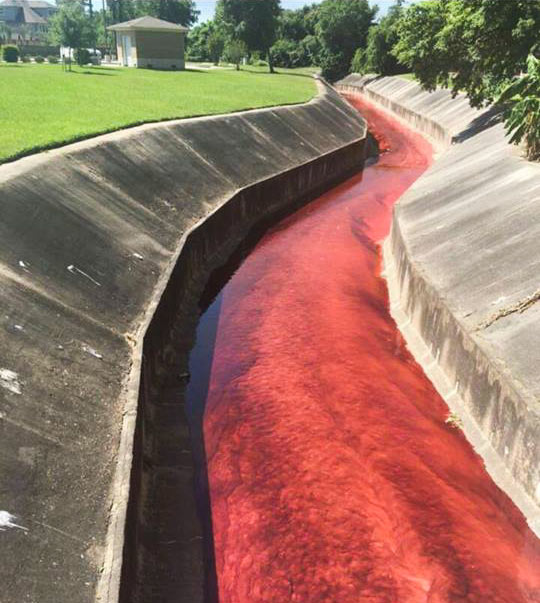
The ditches ran red in the Spring Branch area yesterday as the billowing 4-alarm fire near Laverne St. at Spring Branch Dr. triggered evacuations and shelter-in-place orders across the surrounding areas. The blaze reportedly started in a home-slash-auto-shop on Laverne and spread next door to the A-1 Custom Packaging warehouse (which transfers large quantities of various industrial liquids into smaller bottles for distribution). Some of those stored chemicals (including the bright red petroleum additive visible in the shot above) made their way into drainage ditches and culverts flowing into Spring Branch itself.
The red additive is non-water-soluble and has been getting pushed around by contract clean-up crews downstream to stop the spread. But contractors cannot, the city says, catch the pesticide that also made its way into the same drainage channels, as it dissolves in water. It’s still unclear how much of the 500 gallons or so thought to have been stored at the site made it all the way into Spring Branch (which flows into Buffalo Bayou south of I-10), but some water quality test results are due back later today.
***
The Houston Fire Dept. says that city water supplies are safe to drink, but that anyone with a well in the area should probably get it tested, and the contaminated ditches and streams should be avoided. Captain Ruy Lozano also tells ABC that the site of the fire itself is still producing smoke today and should be avoided as well.
- 500 Gallons of Pesticides at Houston Site Destroyed by Fire [ABC]
- HFD IDS Chemicals in Water After Massive Warehouse Fire in NW Houston [abc13]
- Red Mystery Liquid Leaks Into Drainage Ditch Near Massive Spring Branch Chemical Fire [Houston Press]
- Arson Investigators Working To Determine Cause of Warehouse Fire [KHOU]
- Previously on Swamplot: What’s On Fire in Spring Branch This Morning And Who the City Says Should Worry About It
Photo: Matthew Harkrider





wow. I bet all those people who felt safe avoiding the east end because of pollutants aren’t happy.
On a mountain of skulls, in a castle of pain, I sat on a throne of blood. What was will be! What is will be no more! Now is the season of evil.
@toasty, that’s a false equivalence fallacy. An extraordinary event of extreme rarity and relatively very small in actual damage is not the same as over a century of recorder near daily pollution of great volume and chemical variety with proven casualty of detrimental health effect in east end.
This fire was an isolated incident. Issues on the east side seem more chronic.
FYI re: photo, I’m pretty sure this was taken/posted by @MHark on Twitter
Thanks, NetInterest! The photo originally came to us from another source (who has since removed it); we’ve got the correct credit up now.
Looks like farm diesel
What do you guys mean by “East Side”? Like Gallena Park/Deer Park/Pasedena? Or just anywhere east of I-45? Because if it’s the latter I don’t know where people keep getting this nonsense from. Look, the distance from the first major plants on 225 is roughly 5-10 miles from the east side (5 from idylwood 10 from eado). Want to know how far it is from the Museum District? 10-15 miles. So either there’s a magical forcefield that lines up with 288 that protects the museums but leaves the east end out to dry, or magical wind patterns keep them safe by only blowing eastwardly long enough to hit the east end but then they take a dramatic 90 degree turn, or it’s just a bunch of nonsense that people spout because that’s what makes them feel safe/superior.
.
Now, if you’re talking about Galena Park/Deer Park/Pasadena…well ok we can all feel superior to them. That said though the air quality over there isn’t as bad as some people want to make out.
.
http://aqicn.org/city/texas/houston/clinton/
Somebody needs a new SPCC plan.
Air quality is more than smog. Smog does travel around the city depending on conditions. Toxics (butadiene 1,3, benzene, ethylene, etc.) are generally heavier than air and do not travel very far. People living close to petrochemical plants on the East End will have greater exposure to toxics than people on the west side of Houston. But if you want to live on the west side and still get a good dose of toxics, you can just live within 1000 feet of one of the major highways and get some pretty good tailpipe emissions.
Has this made it to Buffalo Bayou yet? Has anyone seen a red tint in BB?
Drink up Houston. Does anyone know what the “petroleum additive” is? Or the pesticide? Or the actual amount released? How concentrated is that 500 gallons? At what rate will it seep into the groundwater? In order to test well water, one would need to know what to test for and when to test for it. Cheers!
The problem with East End is not just current airborne pollution, it’s the decades of ground pollution from all the former industrial sites that homes are now built on. Plus it’s downstream from all the contaminated ground water. All that stuff finds it’s way up through the ground and into living spaces, not to mention yards.
to everyone saying this is a one time event. yes it is unlikely that this fire will repeat.
.
but this place stores chemicals all the time. Where else are they storing chemicals? The industrial complex on the east side of town makes them.
.
There are monitoring stations all over the east side of town to monitor the localized leaks. are there monitoring stations in spring branch to monitor localized leaks? yeah, didn’t think so. so who knows when there are leaks over there. if you don’t see it happen, it doesn’t happen, right? No one tells you to shelter in place, then everything is okay, right?
.
Yeah.
If you’re a real estate developer and you buy a plat and plunk down houses to presell or build on spec you ought to fully disclose all history of the property and the surrounding areas, too, if its downstream from ground-or surface-water. Whether its next door to a commercial emterprise or on the former site of a rice farm (Shout out to our flooded Northsde brethren!) they should tell all.
But wait, thank Houston for failing to even try to control growth and development in any way and thank your local Texas Republicans for gutting tort law, local control, homebuilder liability and ask him how much money the late Bob Perry and his fellow homebuilders have given them over the last decade or so.
The EPA has a mapping application called the EnviroMapper. Browse through that and, yes, its very clear that the east side of town has the largest concentration of known pollution release points, permitted and otherwise. However, you can also easily see that there are corridors extending to the north, northwest, and south. They follow the most active freight rail lines and the heavy industry that got built up all around them. And then there’s hazmat stuff like this, which can be located basically in any warehouse, office warehouse, distribution center, or manufacturing facility in any part of town and it won’t get onto the map. (Remember the explosion in West, TX? Not gonna be on the map.) Most people don’t realize it but laundromats are a major environmental hazard and have been located all over the older parts of the city at various points in time. This is to say nothing of spills and dumping that happened either illegally or long-enough ago that people just didn’t realize that it was a big problem.
If you want the best odds on avoiding all that stuff, then find yourself a relatively new neighborhood that was built as greenfield development, check historical imagery on Google Earth to confirm what was there previously, buy a house in the interior of it, and be sure that you’re getting your water from a large well-run water system. You should never drive into the city for any sort of business, civic, or educational function without donning a gas mask, and you should bring bottled water from home.
Or you could just accept that there are some risks in life and balance them with the things you value, whatever that may be.
Benzene is a fairly nasty thing to get exposed to, and the reports about that were a little upsetting, but it’s worth noting that those were mostly in Manchester and Gallena Park, which are often literally a stone’s throw from a chem plant. Comparing that with houses on Lockwood is disingenuous at best. As for the ground water pollution due to heavy industry, sure, there are issues with that. But it’s worth recognizing that many of the houses/neighborhoods are nearly 100 years old and not built on top of industrial sites, as opposed to areas like say the Washington corridor which is building new on top of old abandoned warehouses. And then there’s the superfund sites. Where are those you might ask?
http://www.tceq.state.tx.us/remediation/superfund/sites/county/harris.html
Look at all of those superfund sites in the east end! Oh….wait….